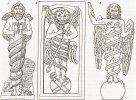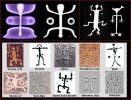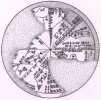Arjuna saw in that universal form unlimited mouths and unlimited eyes. It was all wondrous. The form was decorated with divine, dazzling ornaments and arrayed in many garbs. He was garlanded gloriously, and there were many scents smeared over His body. All was magnificent, all-expanding, unlimited. If hundreds of thousands of suns rose up at once into the sky, they might resemble the effulgence of the Supreme Person in that universal form. At that time Arjuna could see in the universal form of the Lord the unlimited expansions of the universe situated in one place although divided into many, many thousands. Then, bewildered and astonished, his hair standing on end, Arjuna began to pray with folded hands, offering obeisances to the Supreme Lord. Arjuna said: My dear Lord Krsna, I see assembled together in Your body all the demigods and various other living entities. I see Brahma sitting on the lotus flower as well as Lord Siva and many sages and divine serpents. O Lord of the universe, I see in Your universal body many, many forms-bellies, mouths, eyes-expanded without limit. There is no end, there is no beginning, and there is no middle to all this. Your form, adorned with various crowns, clubs and discs, is difficult to see because of its glaring effulgence, which is fiery and immeasurable like the sun. You are the supreme primal objective; You are the best in all the universes; You are inexhaustible, and You are the oldest; You are the maintainer of religion, the eternal Personality of Godhead. You are the origin without beginning, middle or end. You have numberless arms, and the sun and moon are among Your great unlimited eyes. By Your own radiance You are heating this entire universe. Although You are one, You are spread throughout the sky and the planets and all space between. O great one, as I behold this terrible form, I see that all the planetary systems are perplexed. All the demigods are surrendering and entering into You. They are very much afraid, and with folded hands they are singing the Vedic hymns. The different manifestations of Lord Siva, the Adityas, the Vasus, the Sadhyas, the Visvadevas, the two Asvins, the Maruts, the forefathers and the Gandharvas, the Yaksas, Asuras, and all perfected demigods are beholding You in wonder.
O mighty-armed one, all the planets with their demigods are disturbed at seeing Your many faces, eyes, arms, bellies and legs and Your terrible teeth, and as they are disturbed, so am I. O all-pervading Visnu, I can no longer maintain my equilibrium. Seeing Your radiant colors fill the skies and beholding Your eyes and mouths, I am afraid. O Lord of lords, O refuge of the worlds, please be gracious to me. I cannot keep my balance seeing thus Your blazing deathlike faces and awful teeth. In all directions I am bewildered. All the sons of Dhrtarastra along with their allied kings, and Bhisma, Drona and Karna, and all our soldiers are rushing into Your mouths, their heads smashed by Your fearful teeth. I see that some are being crushed between Your teeth as well. As the rivers flow into the sea, so all these great warriors enter Your blazing mouths and perish. I see all people rushing with full speed into Your mouths as moths dash into a blazing fire. O Visnu, I see You devouring all people in Your flaming mouths and covering the universe with Your immeasurable rays. Scorching the worlds, You are manifest. O Lord of lords, so fierce of form, please tell me who You are. I offer my obeisances unto You; please be gracious to me. I do not know what Your mission is, and I desire to hear of it.
Krishna said: Time I am, destroyer of the worlds, and I have come to engage all people. With the exception of you [the Pandavas], all the soldiers here on both sides will be slain. Therefore get up and prepare to fight. After conquering your enemies you will enjoy a flourishing kingdom. They are already put to death by My arrangement, and you, O Savyasacin, can be but an instrument in the fight. All the great warriors-Drona, Bhisma, Jayadratha, Karna-are already destroyed. Simply fight, and you will vanquish your enemies.
Arjuna: O Hrsikesa, the world becomes joyful upon hearing Your name and thus everyone becomes attached to You. Although the perfected beings offer You their respectful homage, the demons are afraid, and they flee here and there. All this is rightly done. O great one, who stands above even Brahma, You are the original master. Why should they not offer their homage up to You, O limitless one? O refuge of the universe, You are the invincible source, the cause of all causes, transcendental to this material manifestation. You are the original Personality, the Godhead. You are the only sanctuary of this manifested cosmic world. You know everything, and You are all that is knowable. You are above the material modes. O limitless form! This whole cosmic manifestation is pervaded by You! You are air, fire, water, and You are the moon! You are the supreme controller and the grandfather. Thus I offer my respectful obeisances unto You a thousand times, and again and yet again! Obeisances from the front, from behind and from all sides! O unbounded power, You are the master of limitless, might! You are all-pervading, and thus You are everything! I have in the past addressed You as O Krsna, O Yadava, O my friend, without knowing Your glories. Please forgive whatever I may have done in madness or in love. I have dishonored You many times while relaxing or while lying on the same bed or eating together, sometimes alone and sometimes in front of many friends. Please excuse me for all my offenses. You are the father of this complete cosmic manifestation, the worshippable chief, the spiritual master. No one is equal to You, nor can anyone be one with You. Within the three worlds, You are immeasurable. You are the Supreme Lord, to be worshiped by every living being. Thus I fall down to offer You my respects and ask Your mercy. Please tolerate the wrongs that I may have done to You and bear with me as a father with his son, or a friend with his friend, or a lover with his beloved. After seeing this universal form, which I have never seen before, I am gladdened, but at the same time my mind is disturbed with fear. Therefore please bestow Your grace upon me and reveal again Your form as the Personality of Godhead, O Lord of lords, O abode of the universe. O universal Lord, I wish to see You in Your four-armed form, with helmeted head and with club, wheel, conch and lotus flower in Your hands. I long to see You in that form.
Krishna said: My dear Arjuna, happily do I show you this universal form within the material world by My internal potency. No one before you has ever seen this unlimited and glaringly effulgent form. O best of the Kuru warriors, no one before you has ever seen this universal form of Mine, for neither by studying the Vedas, nor by performing sacrifices, nor by charities or similar activities can this form be seen. Only you have seen this. Your mind has been perturbed upon seeing this horrible feature of Mine. Now let it be finished. My devotee, be free from all disturbance. With a peaceful mind you can now see the form you desire.
Sanjaya said to Dhrtarastra: The Supreme Personality of Godhead, Krsna, while speaking thus to Arjuna, displayed His real four-armed form, and at last He showed him His two-armed form, thus encouraging the fearful Arjuna. When Arjuna thus saw Krsna in His original form, he said: Seeing this humanlike form, so very beautiful, my mind is now pacified, and I am restored to my original nature.
Krishna said: My dear Arjuna, the form which you are now seeing is very difficult to behold. Even the demigods are ever seeking the opportunity to see this form which is so dear. The form which you are seeing with your transcendental eyes cannot be understood simply by studying the Vedas, nor by undergoing serious penances, nor by charity, nor by worship. It is not by these means that one can see Me as I am. My dear Arjuna, only by undivided selfless service can I be understood as I am, standing before you, and can thus be seen directly. Only in this way can you enter into the mysteries of My understanding. My dear Arjuna, one who is engaged in pure selfless service, free from the contaminations of previous activities and from mental speculation, who is friendly to every living entity, certainly comes to Me.






